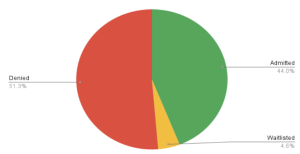We’ve been here all along, the increase in female ADHD
March 27, 2021
It’s a common sight these days–high school or college aged women with above average grades and minimal behavioral records walking into a psychiatrist’s office, only to walk out with a diagnosis of ADHD. When we think of Attention Deficit/Hyperactivity Disorder, we often imagine rowdy younger male students who talk constantly or get reprimanded by teachers for acting out of line, according to a study published in the Journal of Abnormal Child Psychology. We do not imagine academically and socially successful girls or women. Previous data supports these perceptions, with studies finding the childhood ADHD male/female diagnostic ratio to be between 2:1 and 10:1, according to Psychiatry Research. So, why are we seeing an increased amount of women being diagnosed later in life?
In 1952, the Diagnostic and Statistical Manual of Mental Disorders IV (DSM-IV) introduced specific subtypes of ADHD: inattentive and hyperactive-impulsive. One factor that might be playing into the large number of undiagnosed girls is the neglect of the inattentive presentation of the disorder. Data on subtype diagnostics show that women are far more likely to display inattentive ADHD, which manifests itself in more passive ways, according to a study published in the American Journal of Psychiatry. Inattentive individuals are often absent-minded, messy, lose possessions easily, and seem forgetful in daily activities–a contrasting display to the traditional hyperactive manifestation. While in reality, both sectors are experiencing the same effects such as trouble focusing or completing tasks, the inattentive presentation is not obvious to those who aren’t looking closely. This is especially true when the females in question are particularly bright and can perform well in both academic and social settings. However, this doesn’t mean the disorder isn’t there in female students. A study published in 2017 reported that equal percentages of boys and girls observed in classrooms showed signs of ADHD, according to the Journal of Attention Disorders. Yet, the teacher and parental reports for perceived ADHD-based behavior were significantly higher for boys. Bottom line–we aren’t paying enough attention.
Gender roles are present in this equation as well. Girls are taught at a young age to be obedient, passive members of society. While boys are expected to be loud and outgoing, girls are praised for listening to directions and being good examples for behavior. The result–even girls who possess the hyperactive presentation of ADHD display their characteristics in different ways than their male counterparts. Often, hyperactivity can display itself as “excessive chattiness,” excessive emotional responses, or fidgeting, rather than greater behavioral issues as we may expect from males, according to Very Well Mind. Young women with the inattentive front learn to direct their eyesight at the teacher or towards their work to demonstrate “focus” and avoid being reprimanded, when in reality they aren’t absorbing the material and could be struggling to complete the task.
Overall, the societal pretenses that “only boys” have ADHD, the lack of education on the different presentations and the socialization of young women to be passive individuals have cultivated a wave of women going years without the resources or support they need to succeed. That is, until it becomes “too much” and they seek psychiatric evaluation.




